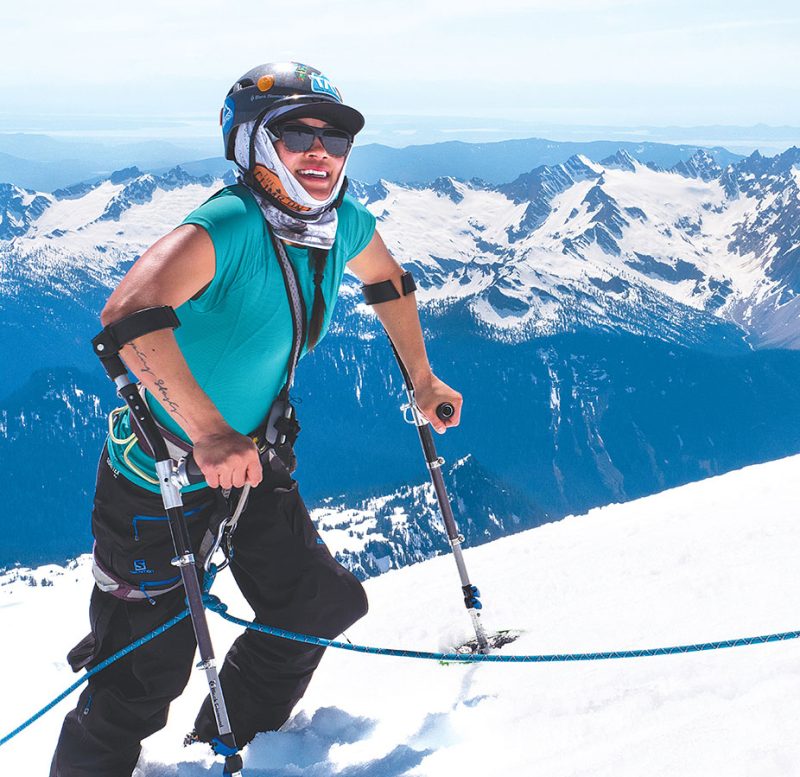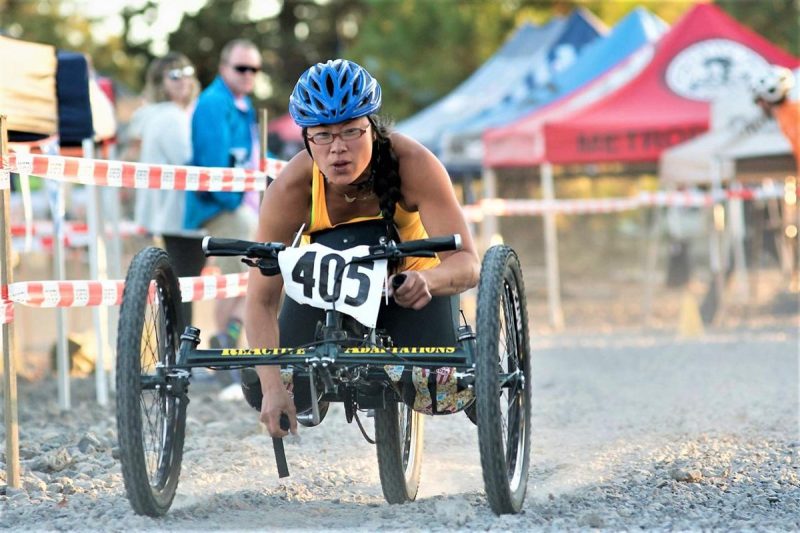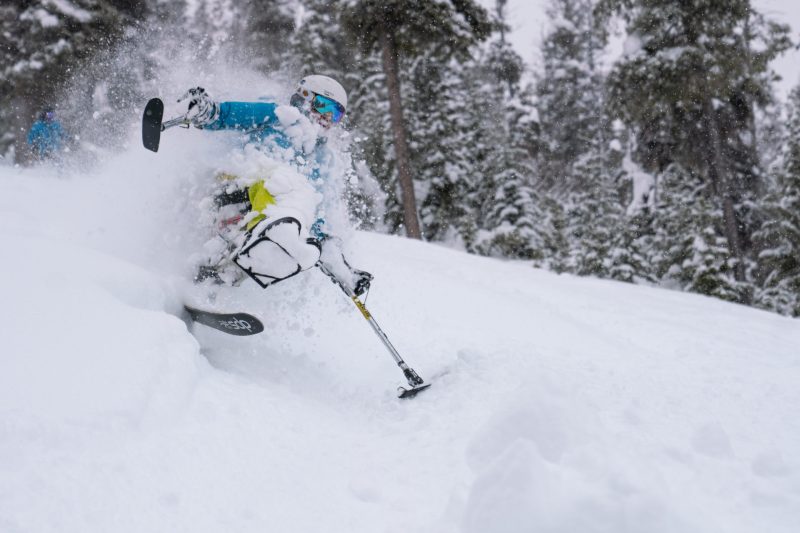Heli-skiing in Alaska is a dream of many skiers and snowboarders. In 2021, Anna Soens accomplished her goal of heli-skiing in Girdwood, Alaska. However, Anna followed a different path to Alaska. In 2015, Anna fell 35 feet in a climbing accident, injuring her spine; doctors said she would never walk again. Anna didn’t let this setback stop her from pursuing her passion for the outdoors.
Before the injury, Anna worked as a wildlife field biologist studying mountain lions and investigating their kills in the remote wilderness of Nevada. Her schedule consisted of two weeks on and one week off. Two weeks studying mountain lions, followed by one-week rock climbing.
In an interview with Mt. Baker Experience Magazine, Anna said this about her job:
“I was basically just paid to camp and hike and follow mountain lions around central and western Nevada,” she said. “I spent eight months that year living out of a backpacking tent and work trucks. I didn’t have a physical address, didn’t have a room to call my own. I lived and worked and breathed outdoors the whole time.”
Then one day at an indoor climbing gym, her life changed. After climbing multiple routes on an auto belay device, which is used to lower climbers slowly, she decided to go for another lap and forgot to clip in. She reached the top of the route, leaned back, and let go, falling 35 feet, breaking her T12 vertebrae. Doctors told her she’d never walk again.
A week after her injury, Anna and her family celebrated Christmas in the hospital. Anna gifted her father a guidebook for climbing Mt. Hood in Oregon, a gift she purchased before the injury, as they planned to climb it together. She told Mt. Baker Experience Magazine,
“I figured I’d still give it to him… I don’t know if I actually believed it was still possible when I gave it to him, but I was hoping for the best.”
In the months after her injury, she regained some leg function and could walk short distances with leg braces and crutches, but tasks she previously did with ease were now a challenge. Balancing her new life in a wheelchair wasn’t as challenging as the realization that she had lost her adventurous, independent life. She told Mt. Baker Experience Magazine:
“After my accident, the actual physical paralysis was kind of secondary. The lack of freedom was what hit me most.”
Shortly after the injury, Anna made physical therapy and recovery the top priority and pushed to make a comeback physically. She couldn’t get back into the field but was at the desk as a U.S. Fish and Wildlife Service biologist. She quickly took up sports like rowing and kayaking and even returned to work.
Anna soon became a pioneer and inspiration for many in the spinal cord injury community by becoming the first woman with paraplegia to summit Mt. Hood in Oregon. Just a year after that achievement, Anna summited Mt. Baker in Washington and completed an 8,000-foot continuous ski descent from the top.

Some engineering needed to be done to get the right gear for Anna to climb those mountains. As you can see in the picture above, those aren’t your average ski poles. Anna and her friends were able to modify the poles by replacing the upper portion with forearm crutches. She plants her ski poles and hoists her body up with her triceps to climb. Anna has strength and some movement in her quads and hip flexors, but overall little use of the rest of her legs. On steep terrain, Anna can direct her feet into steps her climbing partners kick. She gets on all fours into a bear crawl on really steep terrain with crampons and two ice axes.
Anna has been able to pursue her passion with the help of the Kelly Brush Foundation (KBF). The KBF’s mission is to inspire and empower people with spinal cord injuries to live active and engaged lives. The KBF started in 2006, and since then, they have raised over $11.5 million through 1,700 grants to individuals who strive to chase their dreams. In 2016, Anna received a grant from the KBF to help purchase her first off-road handcycle. Since then, Anna has been assisting the KBF as an ambassador to the spinal cord injury community.

After five years of pushing the limits as an adaptive athlete, Anna’s dream of heli-skiing Alaska went full swing. We recently caught up with Anna to learn more about the KBF, her heli-skiing adventure, and her plans.
Anna spoke highly of the KBF and how the organization helped her get back outside doing the activities she loves. Not long after her injury, Anna connected with the KBF, where she could receive financial assistance and support from the community as she transitioned back to her passion for the outdoors.
“Trying to figure out how to live life again, post injury is kind of overwhelming. Everything seems impossible, like physically as well as financially. My sit ski is $7,000 – $8,000, just for the rig, that doesn’t include things like bindings and skis. My mountain bike is like $10,000 – $11,000, everything is more expensive, and fairly unattainable for the average person individually,” Anna said.
“Just in the process of my own recovery and trying to figure out how to get back outdoors, I stumbled across Kelly Brush Foundation, as a resource for people with spinal cord injuries to be able to afford to purchase their own equipment, which is awesome, because all of my equipment, I think has been greatly subsidized by grants of various forms. I just wouldn’t be able to afford it without their help. They gave me a grant for my mountain bike, which is like a three-wheeled, hand-cranked, adaptive mountain bike basically a year after my injury. And they’ve always just been really supportive of all the crazy things I tried to do.”
Anna describes the community surrounding adaptive sports as encouraging and strong-knit. Getting connected to such a welcoming community quickly after her injury helped her through some of the most challenging times.
The active project KBF created allowed Anna to connect further with the adaptive community. She had this to say about the active project:
“KBF developed this thing called the active project, which is this online network resource of basically everything you could ever hope to find when you’re first injured, like other people with injuries, that you can look up on a map and find who’s close to you, all the various local adaptive programs around the country that have equipment that you can try out and different lessons, and etc. They have extensive write-ups on what sports are available for people with spinal cord injuries. Whereas I took basically a year off from life after my injury to just like, figure that stuff out all by myself, because that didn’t really exist yet. And it was all just kind of word of mouth and traveling around and, you know, just kind of reinventing the wheel, which seems silly. And so yeah, I totally wish I had had that resource when I was first injured. And it’s awesome that they’re kind of gathering all of these individual local things going on and putting them into one place so that it can be found easier and more readily by people really soon after their injury.”
“Most people I’ve met with a spinal cord injury, the community has just been such a huge factor in every one of their recoveries. Having other people to give you an example of what’s possible, to share your struggle with you know, I think it’s just it’s so powerful.”
Anna emits infectious high energy with her that drives her to pursue her interests in the outdoors. When asked what fuels her to keep progressing and exploring her passion for the outdoors, Anna said:
“I’d say that the stubbornness and independence my mom always used to get frustrated with me for growing up is paying off now.”
“Finding resources like the KBF so soon after my injury, finding a good community of active disabled athletes really helped shape my perspective post-injury. I’ve met other paras from smaller towns who didn’t really have a support network and they didn’t really do anything for like 10 years or something before they realized that they could ski again. Whereas like, you know, I found those opportunities early, which helps me kind of, I never really questioned that I could keep doing fun stuff.”

Now for the trip every skier and snowboarder dreams of… heli-skiing in Alaska. The KBF approached Anna to try out an ambassador program, where they raised funding for basically any trip she wanted to knock out. That is when Anna set her sights on Alaska.
The preparation for this trip was not as intense as previous adventures, as she didn’t have to worry about the uphill portion this time. Nonetheless, Anna shared some of her concerns and thoughts leading up to the trip.
“To be totally honest, the terrain ended up being a lot mellower than I thought it was going to be. You’re like in this rotation of other skiers, there’s one helicopter serving three or four different groups at a time. And you’re all kind of leveling up on terrain, run by run together. So, they’re not just plopping you down on a 45 degrees slope on day one, which makes sense, but I don’t know you see so many ski films and stuff so leading up to the trip, I was totally in my head like, Oh, God, am I gonna die?, is this the worst decision I’ve ever made?”
When Anna finally reached Alaska, battling the weather window became the main problem.
“I think we were there for like a week, and it was brutal. It was their first snowstorm in like months, which was good because there was more snow but also, the helicopter couldn’t fly. And so, it’s this weird game of waiting for a call from the heli operators. Yeah, we’re going to go or no, we’re going to do a two-hour hold, just like standby and then you just, sit there for two hours staring at your friends just like oh my god like, are we doing this or not. You can’t really do other things because you have to be close in case you get the green light. It’s just like a leak of nerves, and sitting on edge, like changing our flights to stay a couple extra days to try to get the weather window. That ended up working out, we got like one day for that trip which is awesome.”
Completing the heli-ski trip set the tone for what expeditions lay ahead for her. Previous trips like climbing Mt. Hood were more focused on past goals, as it was a project she and her dad had been working on. Not having a skiing background before her injury, Anna feels there is still much to learn and explore in the sport. Sticking out west, Anna has been eyeing Mt. Shasta as potentially her next big trip.
Anna reflects on the heli-skiing trip and other adventures, describing how special they are to her. She stresses her gratitude for the opportunities to explore remote areas and pursue these trips.
“Being in a chair and crutches or whatever, I just don’t have that freedom to just grab a pair of shoes and just go hiking out into the wild for miles and miles. It takes a lot of effort to get into wild spaces and into the backcountry now, so the opportunities I do have to get into somewhere really remote it is just that much more special because of that.”
Building off her gratitude for her experiences, Anna delivers a powerful message. Anna insists she is not intentionally trying to break down barriers or rewrite what is possible for adaptive sports but to show people what should be normal.
“I’m not intentionally trying to push boundaries or do anything rad, in my mind this should be the norm. I feel like I share the things I do to help normalize them, so that when people see someone who’s disabled, don’t congratulate them for you know, going grocery shopping—expect them to do something greater.”
“Societal norms and societal expectations have a huge influence on what people think is possible for themselves. When you’re just crashing into a new world, like you are when you have a new spinal cord injury. Having expectations that are a little bit higher view, I think, can only help elevate your future trajectory.”
“I should not be a pioneer. I should be the norm.”
Anna ended with encouragement to check out KBF and explore its outreach in the community. She emphasized the importance of the outdoors for all of us and how supporting the KBF will allow more people to connect to their passion or discover a new adventure.